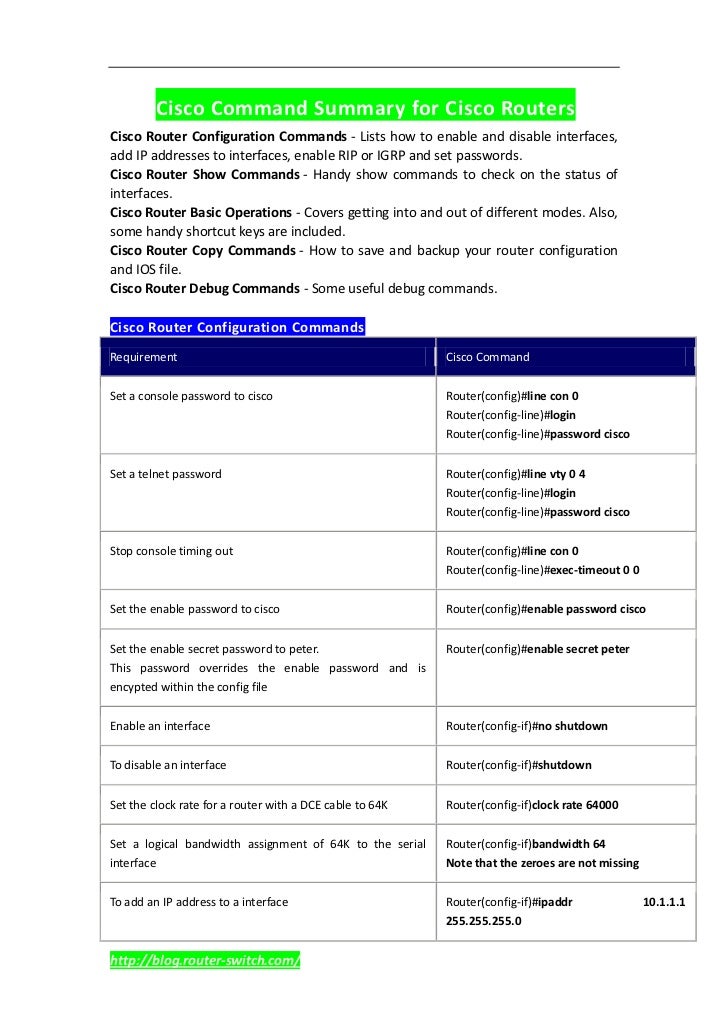

Redundant hot swappable interface modules, fans and power supplies were also included.
#Cisco switch commands upgrade#
1a The sample output in this section displays upgrade from Cisco IOS XE Everest 16.
#Cisco switch commands series#
Buy a Cisco Catalyst 9500 Series 2-Port 40GbE QSFP+ Network Module and get great service and fast delivery. This series is available in 8 port to 48 port configurations. If you are running two switches in stack configuration, do the same on the second flash card. Release Notes for Cisco Catalyst 9600 Series Switches 17. I ran the *boot system flash:*cat9k_iosxe. In this way you can configure LACP EtherChannel in Cisco Switch.Cisco catalyst 9500 configuration guide The Cluster Management Protocol utilizes Telnet internally as a signaling and command protocol between cluster members. Port Vlans in spanning tree forwarding state and not prunedĪs you can see above, Po1 is trunking with 802.1q protocol. Port Vlans allowed and active in management domain Port Mode Encapsulation Status Native vlan You can now verify the TRUNK port using show interfaces trunk command as shown below, Switch-A#show interfaces trunk Use show running-config command in user Exec mode. Switch-B(config-if)#switchport mode trunk Switch-B(config-if)#switchport trunk encapsulation dot1q Switch-B(config)#interface port-channel 1 Repeat same commands in Switch-B as well. Switch-A(config-if)#switchport mode trunk

Switch-A(config-if)#switchport trunk encapsulation dot1q Now, to configure the EtherChannel interface as TRUNK port type following commands as shown below, Switch-A(config)#interface port-channel 1 So, Port-Channel interface running LACP protocol has been created. Port-channel 1 unassigned YES unset up up Interface IP-Address OK? Method Status Protocol You can also verify creation of Port-Channel interface by issuing, show ip interface brief command, Switch-A#show ip interface brief | inc Po1 Similarly, flags regarding ports Fa0/1(P) and Fa0/2(P) – P means these physical ports are member of port-channel 1 (Po1) interface. Regarding flags, Po1(SU) – S means it is operating at layer 2 and U means it is in use. +-+-+-Ībove output shows, Port-Channel Po1 has been created, the protocol is LACP and ports Fa0/1 and Fa0/2 are member of the Port-Channel 1 interface. U - in use f - failed to allocate aggregator To verify the EtherChannel, type show etherchannel summary as shown below. Switch-B(config-if-range)#channel-protocol lacp Switch-B(config-if-range)#channel-group 1 mode active Switch-B(config)#interface range fastEthernet 0/1 - 2 The command channel-group 1 mode active means the physical interfaces Fa0/1 and Fa0/2 will be member of logical EtherChannel interface Port-Channel 1 and the physical ports will actively try to negotiate with remote switch ports to form LACP EtherChannel interface. Here is same configuration for Switch-B.

Switch-A(config-if-range)#channel-protocol lacp Switch-A(config-if-range)#channel-group 1 mode active Switch-A(config)#interface range fastEthernet 0/1 - 2 It is better to start the configuration after shutting down the switch ports to avoid any negotiation issues while configuring LACP. Let’s start configuring LACP in Switch-A. The links between the switches are TRUNKS so we have to configure TRUNK in the LACP bundled port as well. We can bundle these two switch ports into one logical EtherChannel using Link Aggregation Control Protocol (LACP) protocol. The switches are connected with two switch ports Fa0/1 and Fa0/2. The diagram below shows a simple scenario with two Cisco switches, Switch-A and Switch-B. Whereas, in passive mode, the port just waits for remote switch port to initiate LACP negotiation. In active mode, the port actively tries to form LACP EtherChannel with remote switch port. The physical switch ports running LACP protocol can be either in active or passive mode. Configure LACP EtherChannel in Cisco IOS Switch In this post, I will show steps to Configure LACP EtherChannel in Cisco IOS Switch. Link Aggregation Control Protocol (LACP) is a industry standard (IEEE 802.3ad) protocol that is used to bundle two or more links and can work with devices from different vendors. If you are using PAgP protocol then you must use Cisco switches because PAgP is Cisco proprietary protocol. Link Aggregation or Ether Channel is a technology which allows for two or more physical ports to combine into one logical port providing high availability and increased bandwidth.


 0 kommentar(er)
0 kommentar(er)
